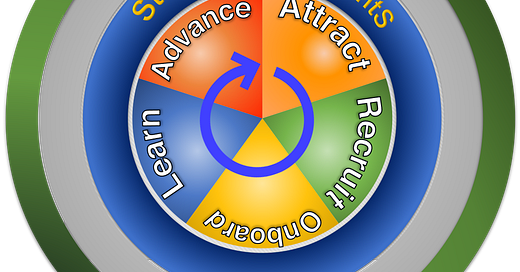2021:3
It’s more than teaching and learning
In this edition of the Student360.Report the focus is on the importance of touchpoints as a tool of focus for the prediction and assessment of student success in higher education.
Our model focuses on touchpoints across the student lifecycle beginning with a prospective student’s first interest in a higher education experience. They continue through the success that comes with the completion of a degree or credential. Touchpoints can also be seen as steps in the journey of an educational experience.
Educators are prone to think of knowledge as the sole stock in trade. Certainly, knowledge is a critical component of what we do in teaching and learning. Notions that student success is defined solely by knowledge gained in a classroom or other learning situation are incomplete and lead to lack of success for students and the institution. Such a narrow focus creates book smart, street dumb for those who do manage to persist to completion.
In our Student360.Design model, educational experiences should be evaluated based on a holistic approach at each student touchpoint. A full analysis often includes a rich analysis of the thoughts and feelings of the student or prospective student, what actions result, and how the touchpoint can be improved to promote success.
Touchpoints - Two Examples
Let’s look at how this works through two examples, one in the learning stage and one in the attract phase.
A few years ago I was in a conference with a renowned professor from the Harvard Business School. As often happens in prof to prof conversations, we exchanged frustrations student progress. His students are often the crème de la crème of business students. Yet, we had a common problem that our students often do not read assigned materials and come unprepared to class.
Engagement with course materials, such as opening and reading a textbook, is a touchpoint. And, it is highly correlated with student success in learning. In today’s world of e-resources and e-texts, the purchase and use of learning materials is measurable and easily known down to the time of access and duration of reading.
Getting beyond such a touchpoint to making meaning out of the data requires more analysis. Recognizing the touchpoint, however, is key to starting.
A touchpoint on the horizon in the attract phase is the use of micro-credentials as a part of the college admission process. There are several experiments including one medical school using a mini-med school MOOC to attract and recruit students. Such tools generate numerous touchpoints from the first point of contact with the student through perhaps an internet click to registration to frequency of interaction.
Micro credentials embedded in a MOOC can be designed with a view towards a progression in the student journey of success. Such a design can include elements of student attitude and perspective, which are often crucial in a holistic admission process.
How many touchpoints?
The question will arise about how many touchpoints are enough to chart likely student success.
Most institutions serve multiple types of students, which could lead to a plethora of touchpoints across the student lifecycle. In addition, web technologies have led to a greater number of touchpoints by potential students and those who later become students. Making sense out of the expanded number of touchpoints across changing student types is critical to success.
The power of CRM technologies may suggest that every data interaction is a touchpoint. Using the blunt force of CRM technology, however, may end up falling into the “measure everything that moves” trap rather than measuring what matters. A different approach is needed.
Our approach rests on finding touchpoints that will inform the quality of the student lifecycle journey, allow for comparative data and benchmarking, and provide degrees of freedom for institutional agility. This approach helps align successful students with institutional strategy.
From touchpoints to data points
The next step after defining touchpoints is to find how to measure, track, and trend data that informs student success. The EduPartner.Solutions approach to this important step is the subject of the next Student360.Report.





